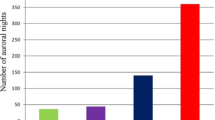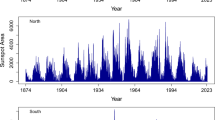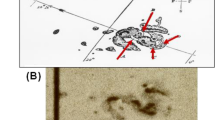Abstract
The statistics of extreme values is used to investigate the statistical properties of the largest areas of sunspots and photospheric faculae per solar cycle. The largest values of the synodic-solar-rotation mean areas of umbrae, whole spots and faculae, which have been recorded for nine solar cycles, are each shown to comply with the general form of the extreme value probability function. Empirical expressions are derived for the three extreme value populations from which the characteristic statistical parameters, namely the mode, median, mean and standard deviation, can be calculated for each population. These three extreme value populations are also used to find the expected ranges of the extreme areas in a group of solar cycles as a function of the number of cycles in the group. The extreme areas of umbrae and whole spots have a dispersion comparable to that found by Siscoe for the extreme values of sunspot number, whereas the extreme areas of faculae have a smaller dispersion which is comparable to that found by Siscoe for the largest geomagnetic storm per solar cycle. The expected range of the largest sunspot area per solar cycle for a group of one hundred cycles appears to be inconsistent with the existence of the prolonged periods of sunspot minima that have been inferred from the historical information on solar variability. This inconsistency supports the contention that there are temporal changes of solar-cycle statistics during protracted periods of sunspot minima (or maxima). Indeed, without such temporal changes, photospheric faculae should have been continually observable throughout the lifetime of the Sun.
Similar content being viewed by others
References
Bray, R. J. and Loughhead, R. E.: 1964, Sunspots, International Astrophysics Series, Vol. 7, Chapman and Hall Ltd., London.
Clark, D. H. and Stephenson, F. R.: 1978, Quart. J. Roy. Astron. Soc. 19, 387.
Court, A.: 1952, in H. E. Landsberg (ed.), Advances in Geophysics, Vol. 1, Academic Press, New York.
Eddy, J. A.: 1976, Science 192, 1189.
Eddy, J. A.: 1977, in O. R. White (ed.), The Solar Output and its Variation, Colorado Associated University Press, Boulder, pp. 51–71.
Fisher, R. A. and Tippett, L. H. C.: 1928, Proc. Camb. Phil. Soc. 24, 180.
Gleissberg, W.: 1977, Sterne und Weltraum 16, No. 7/8, 229.
Gumbel, E. J.: 1942, Bull. Am. Meteorol. Soc. 23, 95.
Gumbel, E. J.: 1954, Nat. Bur. Stand. Appl. Math. Ser. 33.
Gumbel, E. J.: 1958, Statistics of Extremes, Columbia University Press, New York.
Kendall, M. G. and Stuart, A.: 1976, The Advanced Theory of Statistics, Vol. 3, Charles Griffin and Co. Ltd., London and High Wycombe.
Kiepenheuer, K. O.: 1953, in G. P. Kuiper (ed.), The Sun, The University of Chicago Press, Chicago, Illinois, pp. 322–465.
Krumbein, W. C. and Lieblein, J.: 1956, EOS, Trans. Am. Geophys. Union 37, 313.
Link, F.: 1977, Astron. Astrophys. 54, 857.
Link, F.: 1978, Solar Phys. 59, 175.
Siscoe, G. L.: 1976a, J. Geophys. Res. 81, 4782.
Siscoe, G. L.: 1976b, J. Geophys. Res. 81, 6224.
Smith, H. J. and Smith, E. v. P.: 1963, Solar Flares, Macmillan Company, New York.
Tandberg-Hanssen, E.: 1973, Rev. Geophys. Space Phys. 11, 469.
Vitinskii, Yu. I.: 1978, Solar Phys. 57, 475.
Waldmeier, M.: 1955, Ergebnisse und Probleme der Sonnenforschung, Second Edition, Geest und Portig, Leipzig.
Waldmeier, M.: 1961, The Sunspot-Activity in the Years 1610–1960, Zürich Schulthess and Co. AG, Zürich.
Waldmeier, M.: 1976, The Sunspot-Activity in the Years 1961–1975, Astronomische Mitteilungen der Eidgenössischen Sternwarte Zürich, Nr. 346.
Waldmeier, M.: 1977, Sunspot Relative Numbers for 1976, Astronomische Mitteilungen der Eidgenössischen Sternwarte Zürich, Nr. 350.
Author information
Authors and Affiliations
Rights and permissions
About this article
Cite this article
Willis, D.M., Tulunay, Y.K. Statistics of the largest sunspot and facular areas per solar cycle. Sol Phys 64, 237–246 (1979). https://doi.org/10.1007/BF00151435
Received:
Revised:
Issue Date:
DOI: https://doi.org/10.1007/BF00151435




